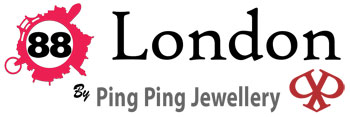All about Jade
Jade FAQs
Is it true there are two types of Jade?
Jade is the English name given to two distinctly different substances – Nephrite and Jadeite.
Nephrite is the famous New Zealand Maori greenstone and the material carved by the Chinese for almost 5,000 years.
Jadeite is the rarer and harder material (a sodium aluminium silicate) which eclipsed Nephrite in China during the 18th century.
Which is the most valuable?
Jadeite.
How much can Jadeite cost?
The best Jadeite, known as ‘Imperial Green’, has a rich, vivid green colour and astounding clarity, with fine carvings selling at specialist auctions in the Far East for millions of US$. Gram for gram, fine Jadeite can be worth more than diamonds. But Jadeite carvings can also be bought from as little as a few pounds.
Which type does Ping Ping use to create its jewellery?
Ping Ping only uses Jadeite.
How do you value Jade?
There is no objective system for valuing Jade precisely. The value of an individual piece relies on its colour tone, how even its colour is, translucency, texture, clarity, amount of flaws and inclusions in the stone and how well it has been cut.
Is Jadeite always green?
No, Jadeite can range in colour from red, yellow and honey-coloured, to lavender, white (known as ‘ice’ Jade) and even black.
Is Jadeite easy to carve?
Being actually harder than steel (around 7.5 on the Mohs scale of hardness) Jadeite has to be worked using diamond-tipped tools and saws.
Is Jadeite mined?
Jadeite is generally extracted from open-cast mines or collected in the form of boulders from river beds.
Is there a lot of fake Jade around?
China is the traditional home of the Jade trade and in Mandarin, the word ‘Jade’ can mean any material that is carved. Thus many Chinese dealers sell materials such as aventurine and serpentine as ‘Jade’- often calling their products names like “Korea Jade” and “New Jade” (serpentine) or “Indian Jade” (aventurine). While such dealers are not necessarily intending to cheat their customers, this situation can be misleading for inexperienced buyers and we have seen some importers selling (innocently or not) what they claim is ‘Jade’ when it is actually other, inferior materials.
What about ‘coloured’ Jade?
Enhancing the colour of Jade is an ancient practice which has been elevated to a science in the 21st century. Colours are injected under pressure with the Jade heated to a certain temperature so as not to damage its molecular structure. Treated in this manner, the colours are permanent and will not fade. Ping Ping does stock some items made using colour-enhanced Jadeite and these are always clearly marked as such. Jadeite can also be clarified using a specialist process to remove impurities and improve its appearance.
However, buyers should be aware of coloured items which are not actually Jade or which have been cheaply dyed. Some unscrupulous dealers will sell colour-enhanced jade as ‘Imperial Jade’: The clue is usually in the price as natural imperial Jade is extremely expensive (see above).
Does Jade have special properties?
Chinese mythology believes that Jade is ‘descended from Heaven’ and so is an extremely lucky material. But Jade has numerous properties ascribed to it by different cultures. The Chinese say that wearing Jade brings wisdom, peace, harmony and focus on spiritual matters; The Spanish Conquistadors believed that it helped cure kidney problems. New Age practitioners say it aids dreaming and helps illuminate a wearer’s true path, as well as promoting relaxation and the efficient completion of tasks. It is also said to be an extremely ‘balanced’ stone. Many Chinese people wear (or display in their cars) lucky and auspicious symbols and figures carved out of Jade for luck, good fortune and safety.
What should I look for when buying Jadeite?
Determining whether a piece of Jade is really Jadeite and whether or not it has been coloured or clarified and then trying to judge its value takes years of experience. However, there are a couple of ‘tricks of the trade’ you can use when buying for yourself.
The first thing that most people do when buying Jade is feel it to make sure it is cold. This at least tells you that it is not plastic! Be aware that Jadeite can heat up under lights or in direct sunlight: It will cool rapidly when removed from the heat source though.
Being very hard, real Jadeite will have no trouble scratching glass – many reputable dealers will offer a sheet of glass so that you can test this.
Shining a light through a piece of Jade (or holding it up to a light source) will reveal its translucence – one of the most important qualities of fine Jade.
If you see any ‘bubbles’ inside the item, it is probably glass.
If you suspect that someone is trying to sell you Serpentine as Jadeite, you should be able to scratch it with a steel blade – although the vendor probably won’t be very happy about you trying this!
Other tests – not really practical outside a laboratory – include flame testing the material, inspecting it in ultra-violet light and measuring its specific gravity, as well as inspection of its molecular structure with a microscope. If you are considering buying an expensive piece of Jadeite in Hong Kong, the seller may agree to have the piece certified in a local laboratory if it has not been done so already.
The famous Jade markets of Hong Kong, Guangzhou and Taipei vary wildly in the quality of Jade items on offer so are the ideal places to visit in order to learn more about this fascinating material.
Finally, the art of Jade buying is based partly on science, instinct, experience and, in large part, trust, so ask yourself if you trust the vendor you are buying from. If not, walk away.
